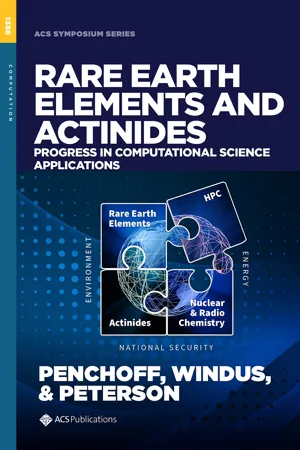
This is a test
- 407 pages
- English
- PDF
- Available on iOS & Android
eBook - PDF
Rare Earth Elements and Actinides: Progress in Computational Science Applications
Kenn,
Book details
Table of contents
Citations
Frequently asked questions
At the moment all of our mobile-responsive ePub books are available to download via the app. Most of our PDFs are also available to download and we're working on making the final remaining ones downloadable now. Learn more here.
Both plans give you full access to the library and all of Perlego’s features. The only differences are the price and subscription period: With the annual plan you’ll save around 30% compared to 12 months on the monthly plan.
We are an online textbook subscription service, where you can get access to an entire online library for less than the price of a single book per month. With over 1 million books across 1000+ topics, we’ve got you covered! Learn more here.
Look out for the read-aloud symbol on your next book to see if you can listen to it. The read-aloud tool reads text aloud for you, highlighting the text as it is being read. You can pause it, speed it up and slow it down. Learn more here.
Yes, you can access Rare Earth Elements and Actinides: Progress in Computational Science Applications by Deborah A. Penchoff, Theresa L. Windus, Charles C. Peterson, Deborah A. Penchoff, Edward Valeev, Heike Jagode, Piotr Luszczek, Anthony Danalis, George Bosilca, Robert J. Harrison, Jack Dongarra, Theresa L. Windus, Ana de Bettencourt-Dias, Deborah A. Penchoff, Charles B. Sims, Theresa L. Windus, Kenn, Deborah A. Penchoff, Theresa L. Windus, Charles C. Peterson in PDF and/or ePUB format. We have over one million books available in our catalogue for you to explore.
Information
Publisher
American Chemical SocietyYear
2021ISBN
9780841298248
Table of contents
- Rare Earth Elements and Actinides: Progress in Computational Science Applications
- ACS Symposium Series1388
- Foreword
- Preface
- Part I: Rare Earth Elements and Actinides: History and Global Challenges
- An Introduction to High Performance Computing and Its Intersection with Advances in Modeling Rare Earth Elements and Actinides
- The Periodic Table and the f Elements
- Rare Earth Elements and Critical Materials: Uses and Availability
- A Brief Overview of Radiochemistry
- A Brief on Nuclear Waste at the Hanford Site and a Computational Analysis of Uranyl Nitrate with and without Tributyl Phosphate
- Part II: Advances in Supercomputing and Methods Development
- Computational Image Techniques for Analyzing Lanthanide and Actinide Morphology
- Advances in Structure Prediction of Lanthanides and Actinides with Genetic Algorithms
- Opportunities for Computational Development in Laser Induced Breakdown Spectroscopy (LIBS)
- Computation of Vibrational Excitations in XPS Spectroscopy
- On the Finite Nuclear Effect and Gaussian Basis Sets for Four-Component Dirac Hartree−Fock Calculations
- Tailored Computational Approaches to Interrogate Heavy Element Chemistry and Structure in Condensed Phase
- Part III: Applications in Surface Science, Ligand Design, Binding Analysis, and Covalency
- Essential Aspects of Solvent Effects and Solution Conditions upon the Modeling and Simulation of Lanthanide and Actinide Complexes
- Targeted Alpha Therapy
- Electronic Structure and Spectroscopy of f-Element Tris(cyclopentadienyl) Complexes
- Development of an Open Source Tool for Basis Set Optimizations and Application to the Development of a Quadruple-ζ Segmented Basis Set for Actinium
- Computational Modeling of Diphosphine Oxide and Diglycolamide Ligand Complexation to Lanthanides and Extraction from Acidic Media
- Molecular Dynamics Simulations of U(III) and U(IV) in Molten Chlorides
- Editors’ Biographies
- Indexes
- Author Index
- Subject Index
- Preface
- Part I: Rare Earth Elements and Actinides: History and Global Challenges
- An Introduction to High Performance Computing and Its Intersection with Advances in Modeling Rare Earth Elements and Actinides
- The Periodic Table and the f Elements
- Rare Earth Elements and Critical Materials: Uses and Availability
- A Brief Overview of Radiochemistry
- A Brief on Nuclear Waste at the Hanford Site and a Computational Analysis of Uranyl Nitrate with and without Tributyl Phosphate
- Part II: Advances in Supercomputing and Methods Development
- Computational Image Techniques for Analyzing Lanthanide and Actinide Morphology
- Advances in Structure Prediction of Lanthanides and Actinides with Genetic Algorithms
- Opportunities for Computational Development in Laser Induced Breakdown Spectroscopy (LIBS)
- Computation of Vibrational Excitations in XPS Spectroscopy
- On the Finite Nuclear Effect and Gaussian Basis Sets for Four-Component Dirac Hartree−Fock Calculations
- Tailored Computational Approaches to Interrogate Heavy Element Chemistry and Structure in Condensed Phase
- Part III: Applications in Surface Science, Ligand Design, Binding Analysis, and Covalency
- Essential Aspects of Solvent Effects and Solution Conditions upon the Modeling and Simulation of Lanthanide and Actinide Complexes
- Targeted Alpha Therapy
- Electronic Structure and Spectroscopy of f-Element Tris(cyclopentadienyl) Complexes
- Development of an Open Source Tool for Basis Set Optimizations and Application to the Development of a Quadruple-ζ Segmented Basis Set for Actinium
- Computational Modeling of Diphosphine Oxide and Diglycolamide Ligand Complexation to Lanthanides and Extraction from Acidic Media
- Molecular Dynamics Simulations of U(III) and U(IV) in Molten Chlorides
- Editors’ Biographies
- Indexes
- Author Index
- Subject Index